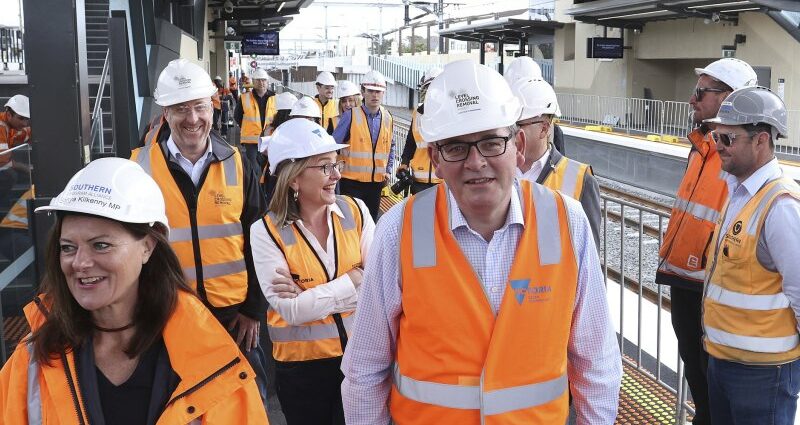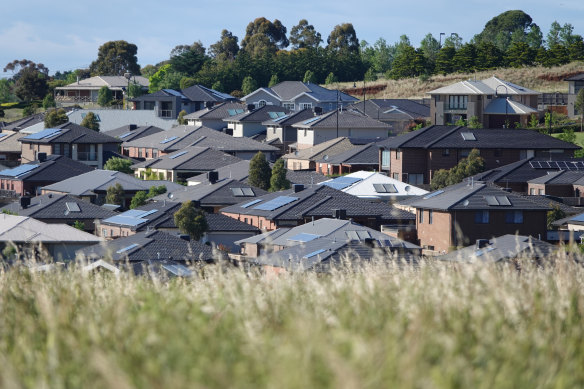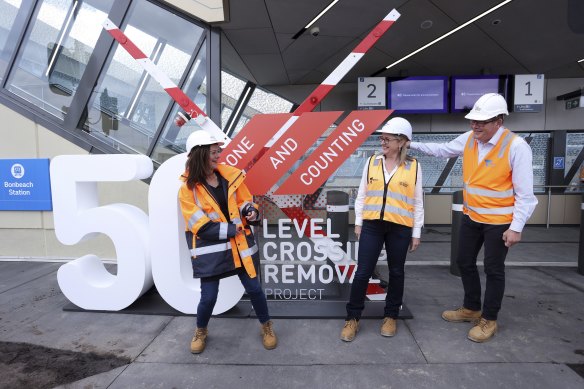Save articles for later
Add articles to your saved list and come back to them any time.
Key points
- The Victorian government has failed meet its target of directing 70 per cent of housing growth to established areas.
- Infrastructure Victoria warns Melbourne needs to build 44,000 new homes annually to accommodate an extra 3.1 million people by 2051.
- Government figures anticipate a reduced role for local councils in site-specific planning decisions as part of statewide reform.
- Before it was ditched, the Victorian government planned to raise $800 million from a social housing levy on new developments.
Local councils could be cut from decision-making on major development projects under a bold plan being considered by the Andrews government to help squeeze an extra million homes into Melbourne’s suburbs by 2050.
In the first major comments about her vision for Melbourne, Planning Minister Sonya Kilkenny flagged concerns about urban sprawl to a property industry forum, promising to urgently promote development in established suburbs rather than greenfield areas on the city outskirts.
Many buy on Melbourne’s fringes because home packages are cheaper but would prefer to live closer to the city.Credit: Paul Rovere
Kilkenny acknowledged the government had failed to meet its own target of directing 70 per cent of housing growth to established areas, warning an extra 1 million homes would need to be built in existing suburbs by 2050.
According to the 2021 census, there are about 2.1 million dwellings in Greater Melbourne. That suggests one new home would need to be built for every two existing homes within the city’s boundaries to hit the 2050 target.
“Application of the 70-30 [target] requires 1 million new dwellings to be delivered in established areas by 2050 to accommodate Melbourne’s projected population growth. We’re not tracking well,” Kilkenny told the Property Council forum two weeks ago.
She said just 56 per cent of new dwellings since 2014 were in established areas, while the rest were in greenfield sites on the urban fringe.
“My priority this year will be on refocusing our efforts to guide and support development into established areas of Melbourne and regional Victoria and inserting a real sense of urgency into this.”
Two government ministers, who were unable to publicly discuss cabinet deliberations, told The Age that Kilkenny and Infrastructure Minister Jacinta Allan were working on reforms to streamline planning for new housing near public transport in established suburbs, including along the government’s flagship Suburban Rail Loop.
The reform push follows growing alarm that Melbourne is on the cusp of a major housing crunch that could jeopardise Victoria’s economic recovery, compounded by soaring construction costs, skills shortages, competition from major infrastructure projects and rising interest rates.
The ministers said the government was increasingly frustrated with planning delays at the local level and the reluctance of councillors to support higher-density projects because of the fear of local backlash.
The plans also reflect an acknowledgement that all the new infrastructure required for sprawling greenfield suburbs – including schools, hospitals and public transport – is no longer sustainable for the debt-laden state.
State cabinet is yet to finalise the reforms, but senior state and local government figures anticipate a reduced role for councils in site-specific planning decisions. Whether the changes will be limited to planning in designated precincts is not yet clear.
But within the government’s senior ranks, there is anxiety about the potential impacts on local communities and, therefore, votes.
“The government does not have a social licence for a higher-density city,” said one senior government insider, who highlighted concerns about the lack of open space and parkland in built-up suburbs.
Infrastructure Victoria released a report last month warning Melbourne needed to build about 44,000 extra homes a year to accommodate an extra 3.1 million people by 2051.
Such growth necessitated an extra 932,000 new homes in Melbourne’s existing suburbs by 2051 – eight times the number of existing homes in the whole of Geelong – the report said.
“The supply challenge is large, especially if new homes are to meet the needs and aspirations of Victoria’s diverse and growing population at prices they can afford,” it said.
“The share of new homes built in established suburbs is declining, and in 2021, fewer than half were in Melbourne.”
Planning Minister Sonya Kilkenny, Deputy Premier Jacinta Allan and Premier Daniel Andrews in November 2020.Credit: Paul Jeffers
Councillors are bracing for what some expect to be the biggest shake-up of the planning system since the Kennett government’s overhaul 25 years ago.
Veteran Mornington Peninsula Shire councillor David Gill said local and state government figures had flagged sweeping changes that would remove much of the statutory planning decisions from councils.
He said councils were often unfairly criticised for slow planning, but he pointed to a chronic shortage of professional planners as a major problem for both local and state governments.
Gill said that sidelining councils came with big risks to neighbourhood character – and to MPs.
“The outcome is potentially awful for local communities and Melbourne,” said Gill. “The state doesn’t know what local communities want. It doesn’t want to know.”
But planning consultant Marcus Spiller said the dire need for affordable housing near jobs, transport and services justified a greater role for the state.
“To achieve housing supply at scale, it would be reasonable and responsible to lift planning for priority precincts from local government,” he said.
Another potential challenge for the government would be fielding criticism that such planning reforms were a backflip on a promise from early last year after the collapse of the proposed social housing levy.
Under the shelved Social and Affordable Housing Contribution, the government had to rake in about $800 million a year from a charge on new housing development.
Controversially, the government linked the levy to a suite of planning reforms to fast-track approvals, including a reduced role for councils.
After the Property Council opposed the 1.75 per cent levy, the government abandoned the social housing scheme and planning reforms. Premier Daniel Andrews said at the time: “I am not in the business of creating super profits for developers if they are unwilling to support sharing those profits.”
One minister said the government was again looking at how to harness more funds from developers for social and affordable housing.
Spiller, the planning consultant, said if the government intervenes in the planning system to make housing development more profitable, Victorians should be the main beneficiary.
“The government needs to ensure that the wider community benefits from the uplift in property value that comes with rezoning for higher-density housing and from the streamlining of planning approvals,” he said. “Some form of levy or inclusionary zoning is needed.”
The Victorian government did not respond to questions by deadline.
The Morning Edition newsletter is our guide to the day’s most important and interesting stories, analysis and insights. Sign up here.
Most Viewed in National
From our partners
Source: Read Full Article
-
'Big spenders will pick Paris over London if tourist tax remains'
-
Sterling slumps to lowest against the dollar in a week after Truss axe
-
'Homophobic attack' victim feels 'lucky' after leaving hospital
-
UK heatwave to return in days as maps show scorching weather
-
2,000 cafés and 350 tattoo studios opened on High Streets since Covid



